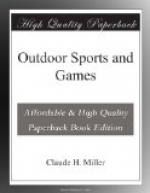CANE RUSH
This contest is usually held in colleges between the rival freshman and sophomore classes. A cane is held by some non-contestant and the two classes endeavour by pulling and pushing and hauling to reach the cane and to hold their hands on it. At the end of a stated time, the class or side having the most hands on the cane is declared the winner. It is a very rough and sometimes dangerous game and in many colleges has been abolished on account of serious injuries resulting to some of the contestants.
CANOE TILTING
This is a revival of the ancient game of tilting as described in “Ivanhoe,” except that the tilters use canoes instead of horses and blunt sticks in place of spears and lances. The object is for the tilter to shove his opponent out of his canoe, meanwhile seeing to it that the same undesirable fate does not fall to his own lot. In singles each contestant paddles his own canoe with one end of his pike pole, but the sport is much greater if each canoe has two occupants, one to paddle and the other to do the “tilting”.
CAT
A small block of wood pointed at both ends is used in this game. The batter strikes it with a light stick and as it flies into the air attempts to bat it with the stick. If the cat is caught the batter is out. Otherwise he is entitled to a score equal to the number of jumps it will take him to reach the place where the cat has fallen. He then returns to bat again and continues until he is caught out.
COUNTING-OUT RHYMES
Almost every section has some favourite counting-out rhyme of its own. Probably the two most generally used are:
“My mother told me to take this one,”
and that old classic—
“Eeny, meeny, miny, mo. Catch a nigger by the toe; If he hollers, let him go. Eeny, meeny, miny, mo.”
This is also varied into
“Ena, mena, mona, mite. Pasca, laura, bona, bite. Eggs, butter, cheese, bread. Stick, stock, stone dead.”
The object of a counting-out rhyme is to determine who is to be “it” for a game. As each word is pronounced by the counter some one is pointed at, and at the end of the verse the one last pointed at is “it.”
COURT TENNIS
This game, though very similar to rackets and squash, is more scientific than either. The court is enclosed by four walls. A net midway down the court divides the “service” side from the “hazard” side. The rackets used in court tennis have long handles and a large face. The balls used are the same size as tennis balls, but are heavier and stronger. In play, the ball rebounds over the court and many shots are made against the roof. While somewhat similar to lawn tennis, the rules of court tennis are extremely complicated. The game is scored just as in lawn tennis, except that instead of calling the server’s score first the marker always announces the score of the winner of the last stroke.




